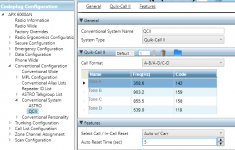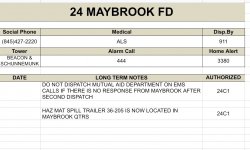[Here] is a list of fire departments in Orange County, NY and their paging tones. They use Quick Call II. I've taken recordings of toneouts and used Audacity to confirm that these frequencies are still accurate.
I have some documents from the dispatch center which look like this:

There is a document like this for each department. Each document lists a three digit "Alarm Call" and a four digit "Home Alert," which I assume are cap codes. I tried decoding them with [this guide] to see if they matched the frequencies listed above, but I was having some issues.
I tried decoding the "Alarm Call" with the "General Encoding Method (3 Digit Cap Code)," but the tones I got don't match the listed tones above.
I'm not sure what method to use to decode the "Home Alerts." The "Metro-Page/Centracom System Method" is the only listed method which produces 4-digit numeric cap codes, but it doesn't seem to be the correct method. Coldenham FD, for instance, has a Home Alert of 5395, but [this table] seems to suggest that a cap code can't start with 53.
Here are some more departments along with their Alarm Calls, Home Alerts and paging tones.
Am I just decoding the cap codes incorrectly? Are they even cap codes or are they something else?
I have some documents from the dispatch center which look like this:

There is a document like this for each department. Each document lists a three digit "Alarm Call" and a four digit "Home Alert," which I assume are cap codes. I tried decoding them with [this guide] to see if they matched the frequencies listed above, but I was having some issues.
I tried decoding the "Alarm Call" with the "General Encoding Method (3 Digit Cap Code)," but the tones I got don't match the listed tones above.
I'm not sure what method to use to decode the "Home Alerts." The "Metro-Page/Centracom System Method" is the only listed method which produces 4-digit numeric cap codes, but it doesn't seem to be the correct method. Coldenham FD, for instance, has a Home Alert of 5395, but [this table] seems to suggest that a cap code can't start with 53.
Here are some more departments along with their Alarm Calls, Home Alerts and paging tones.
| Department | Alarm Call | Home Alert | [Siren] A Tone | [Siren] B Tone | [Pager] A Tone | [Pager] B Tone | [Pager] C Tone |
|---|---|---|---|---|---|---|---|
| Bullville | 679 | 4427 | 532.5 | 697.5 | 1530 | 1743 | 1036 |
| Campbell Hall | 453 | 1207 | 907.5 | 817.5 | 524.6 | 953.7 | 1082 |
| Chester | 407 | 5106 | 667.5 | 532.5 | 1930.2 | 726.8 | 977 |
| Circleville | 230 | 5301 | 832.5 | 652.5 | 1930.2 | 1122.5 | 1326 |
| Coldenham | 217 | 5395 | 607.5 | 517.5 | 2688 | 1232 | 1130 |
| Cornwall-on-Hudson | 294 | 2365 | 667.5 | 562.5 | 950 | 1232 | 1130 |
| Cronomer Valley | 496 | 2494 | 622.5 | 952.5 | 1036 | 1598 | 1743 |
| Cuddebackville | 421 | 1336 | 772.5 | 712.5 | 643 | 1287 | 1430 |
| Florida | 203 | 1210 | 652.5 | 832.5 | 589.7 | 799 | 732 |
| Fort Montgomery | 416 | 1325 | 712.5 | 952.5 | 615.8 | 1232 | 1598 |
| Goodwill | 447 | 1390 | 862.5 | 532.5 | 799 | 1082 | 1232 |
| Goshen | 628 | 2410 | 772.5 | 562.5 | 810.2 | 1433.4 | 1669 |
| New Windsor | 440 | 1150 | 862.5 | 667.5 | 707.3 | 524.6 | 646 |
Am I just decoding the cap codes incorrectly? Are they even cap codes or are they something else?



